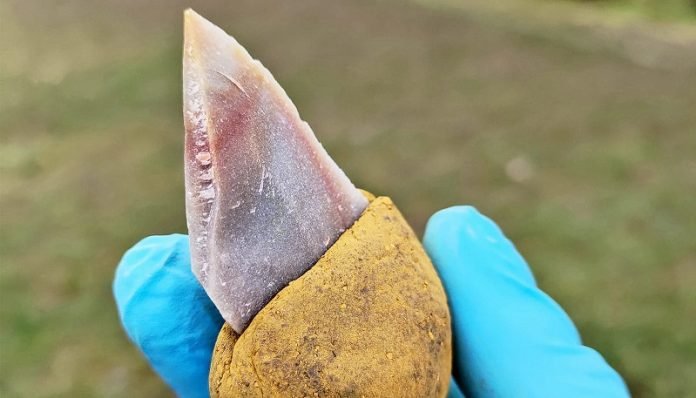
Long before the invention of super glue in our modern world, Neanderthals were ahead of their time, creating an adhesive that has left scientists in awe.
This groundbreaking discovery reveals that our ancient relatives were far more advanced than previously believed, showcasing their ability to think, plan, and innovate.
In the heart of France, at an archaeological site known as Le Moustier, researchers stumbled upon stone tools dating back between 120,000 and 40,000 years.
These tools, which had been lying untouched in Berlin’s Museum of Prehistory and Early History since the 1960s, held a secret ingredient – a mixture of ochre and bitumen, forming a sort of ancient ‘glue’.
Ochre, a natural earth pigment, and bitumen, a component of asphalt, might not seem like materials for making glue.
However, Neanderthals discovered that mixing these two substances in just the right way could create a sticky mass perfect for attaching stone tools to handles.
This adhesive was cleverly designed to stick the tools together without sticking to the Neanderthals’ hands, a feature that even modern adhesives strive to achieve.
The composition of the glue was surprising to researchers; it contained more than 50% ochre. This was unexpected because bitumen alone can act as a glue, but its adhesive properties diminish when mixed with such a large amount of ochre.
Yet, the Neanderthals found a way to make it work, resulting in a durable and effective adhesive.
Microscopic analysis of these tools revealed wear patterns that confirmed the glue was used to attach the tools to handles, enhancing their usability and effectiveness.
This innovation wasn’t just about making tools; it was a reflection of the Neanderthals’ complex thinking and cultural development. It showed they could plan, as collecting the raw materials required effort and possibly travel to different locations.
This discovery challenges our understanding of Neanderthals and their cognitive abilities. It places them on a similar intellectual level with early Homo sapiens in Africa, who also developed complex adhesives.
Such technological advancements are among the earliest evidence of modern thinking and problem-solving skills that are still characteristic of humans today.
This study not only shines a light on the ingenuity of Neanderthals but also on their cultural evolution. By making and using this ‘super glue’, Neanderthals demonstrated a level of thought and planning that brings us closer to understanding our ancient relatives.
Their legacy, preserved through these tools, continues to reveal the depths of human innovation and adaptability.
The study appears in the journal Science Advances.



